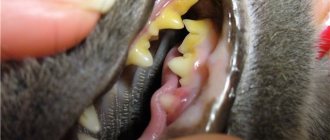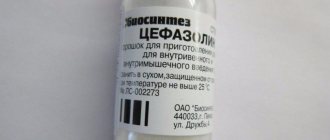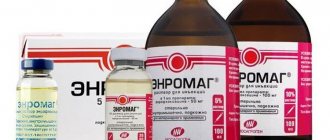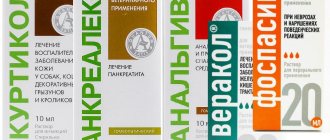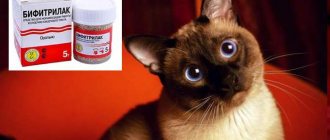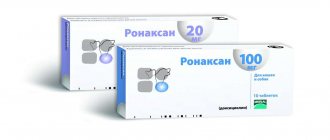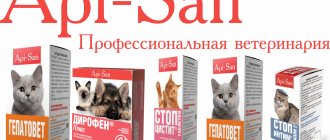The drug "Sereniya" for cats and dogs is an antiemetic drug that is successfully used in the veterinary field for prolonged vomiting in animals. The medicine was developed by the American company Zoetis Inc. It quickly gained popularity among Russian pet owners and veterinarians. Before using this drug, you need to familiarize yourself with its features and dosage forms.
Composition and release form of the drug
Sereniya is available in the form of an injection solution and tablets, and each form has its own application features.
As for the composition, the main active ingredient in the drug is maropitant citrate, the task of which is to stop vomiting in animals. Among other substances, it contains metacresol (a strong antiseptic) and sodium cyclodestrin (increases the solubility of the macronutrient).
Injection solution
The solution is a clear liquid with a slight yellowish tint. It goes on sale packaged in 20 ml glass bottles, sealed hermetically with rubber stoppers, which are rolled up with aluminum caps on top. The manufacturer does not produce bottles of other sizes.
Pills
The drug in tablet form is marketed in four different versions. Their composition is the same, but the difference lies in the mass and concentration of the main active ingredient, as well as additional components. Cats can be given 100 and 150 mg tablets containing 16 and 24 mg of maropitant.
Sereniya tablets, which have a yellow tint, have one advantage - the content of the active substance is stamped on one side, which eliminates the risk of exceeding the dosage (even if the packaging is lost). In addition, for more convenient separation of the tablet, a special dividing strip is provided.
Each package contains an aluminum foil blister containing four tablets.
Learn about essential drugs in animals
- Instructions for use of Dirofen in cats
- Instructions for use of Vetom in cats. Explore the breadth of the vetom effect for the complex treatment of many pathologies in cats
- Instructions for using multifel in cats. The effect of multifel-4 for the comprehensive fight against multiple infections in cats
- Instructions for use of fosprenil in cats
- Instructions for the use of Kotervin in cats. The breadth of the anti-inflammatory, saluretic effect of Cotervin for the complex treatment of many pathologies in cats
- Instructions for use Kot Bayun in cats
- Instructions for the use of feliferon in cats. Explore the breadth of the immunomodulatory effect of feliferon for the complex treatment of many pathologies in cats
- Instructions for using stronghold in cats. Stronghold Spot On effect for cats.
- Instructions for use of Milbemax in cats. Milbemax - for the complex treatment of many pathologies in cats
- Information about the drug Gamavit, features of its use are provided, excerpts from the instructions are collected, doses for cats are indicated, indications and contraindications for the use of Gamavit for cats
- Instructions for the use of spirovet in animals. Calculate the optimal dose of the drug in dogs, cats, pigs, cows, sheep, goats. Explore the breadth of the antibacterial effect of Spirovet in veterinary medicine
- Instructions for the use of tiamulin in birds and animals. Calculate the optimal dose of the drug in dogs, cats, pigs, cows, sheep, goats, chickens, turkeys, broilers. Explore the breadth of tiamulin's antibacterial effects in veterinary medicine
- Instructions for use of Sevaxel in animals. Calculate the optimal dose of the drug in dogs, cats, pigs, cows, sheep, goats. Explore the breadth of sevaxel's antibacterial effects in veterinary medicine
- Instructions for the use of thiam-oxy in animals. Calculate the optimal dose of the drug in pigs. Explore the breadth of antibacterial effects of thiam-oxy in veterinary medicine
- Instructions for the use of tetravet in animals. Calculate the optimal dose of the drug in dogs, cats, pigs, cows, sheep, goats. Explore the breadth of tetravet's antibacterial effects in veterinary medicine
- Instructions for the use of TAF 25% in chickens, turkeys and other animals. Calculate the optimal dose of the drug in birds. Explore the breadth of the antibacterial effect of TAF 25% a in veterinary medicine
- Instructions for the use of cefkinome in animals. Calculate the optimal dose of the drug in pigs, cows, sheep, goats, horses, dogs and cats. Explore the breadth of cefkinome's antibacterial effects in veterinary medicine
- Instructions for the use of intramycin in animals. Calculate the optimal dose of the drug in dogs, cats, pigs, cows, sheep, goats
- Instructions for the use of inotil in animals. Calculate the optimal dose of the drug in dogs, cats, pigs, cows, sheep, goats. Explore the breadth of inotil's antibacterial effects in veterinary medicine
- Instructions for the use of cobactan in dogs. Calculate the optimal dose of the drug. Explore the breadth of the antibacterial effect of cobactan in cats
- Instructions for the use of coliside in animals. Calculate the optimal dose of the drug in birds, pigs, cows, sheep, goats. Explore the breadth of coliside's antibacterial effects in veterinary medicine
- Instructions for the use of Marbox in animals. Calculate the optimal dose of the drug in dogs, cats, pigs, cows, sheep, goats. Explore the breadth of Marbox's antibacterial effects in veterinary medicine
- Instructions for the use of inosel in animals. Calculate the optimal dose of the drug in dogs, cats, pigs, cows, sheep, goats. Explore the breadth of the antibacterial effect of the drug inosel in veterinary medicine
- Instructions for the use of oxytetra in animals. Calculate the optimal dose of the drug in dogs, cats, pigs, cows, sheep, goats. Explore the breadth of oxytetra's antibacterial effects in veterinary medicine
^Top
Effect of Serenia on cats
Serenia helps not only in situations where the animal feels sick or vomits due to being seasick during a trip. This drug should always be present in the veterinary medicine cabinet, since it may be needed after a course of therapy with chemical or antibacterial drugs, as well as during the cat’s recovery from anesthesia after surgery.
Serenia is an antiemetic agent that is active in vomiting of peripheral and central origin.
The main active ingredient, after administration of the drug under the skin, is absorbed in a short time and reaches the maximum serum concentration after 45 minutes. Sulfur is 90% bioavailable, 99% bound to plasma proteins, metabolized by the liver and excreted in feces. Maropitant citrate belongs to the third hazard class, that is, moderately dangerous.
Cost of the product
The price of 1 bottle with 20 injection mixtures ranges from 4,500 to 4,900 rubles. The cost of 1 pack of tablets varies in the range of 300–450 rubles. Some veterinary pharmacies and pet stores practice selling medications individually (70–80 rubles each). It is not advisable to purchase a 20 ml bottle, since most of the medication has to be thrown away, so some veterinary clinics offer the purchase of the drug by the bottle.
In this case, the medication is immediately drawn into a measuring syringe.
Instructions for use and dosage of Serenia for cats
The drug should be given to animals in the dosages indicated in the recommendations for its use.
Injections are best suited when the cat is vomiting due to something getting into the stomach. In this case, tablets will not give the desired result, since the active substance simply will not have time to act before the next urge to vomit. Therefore, tablets are given to pets only before trips to prevent motion sickness, and in all other cases it is better to give injections.
And for the best therapeutic effect, it is not recommended to do the following::
- feed your pet an hour before taking the drug;
- mix tablets with fatty foods (for example, cheese, meat, etc.);
- Give the next tablet or give an injection until a day has passed since taking the previous ones.
Injection solution
The injection solution is administered to cats under the skin at the rate of 1 ml of the drug per 10 kg of live weight. In order not to make a mistake when taking the required amount of solution, it is better to use an insulin syringe. It also has a thin needle, which will make the process of administering the drug easier. You can prick a cat yourself, but you will need to secure it during the procedure so that it does not twitch.
Only one injection per day is allowed, the course of treatment is a maximum of 5 days, but usually one or two injections are enough for the vomiting to stop and the animal to feel better. But if a cat vomits very strongly and often, then she will most likely need the maximum course of treatment.
Pills
The drug in tablet form, as mentioned above, is used only to prevent motion sickness, and not to treat the animal.
Only before the trip takes place, the active substance must have time to act, so the cat should be given the tablet a few hours before it. If your pet refuses to take the medicine, it can be hidden in the food.
Usually, a single dose is enough for the cat to tolerate the trip well, and repeated doses after a day may be required only in extreme cases. The dose of the medicine is calculated as follows: per 1 kg of cat’s body weight, 8 mg of the active substance is required. This means that one 100 mg tablet can be given to a cat whose weight is 2 or 2.5 kg.
Storage conditions
It is recommended to store sulfur in a dry place protected from light. Avoid exposure to direct sunlight and ensure storage away from children. The manufacturer on the packaging indicates a shelf life of 3 years under proper conditions, where the room temperature should not exceed +25 degrees for the solution and +30 for tablets. After opening the bottle, it is recommended to store the drug for no more than 90 days. Using the medication as directed will help your cat get rid of the gag reflex during the recovery period after surgery, as well as during motion sickness in transport.
Vomiting in a cat, the main reasons, what to do
Visit the profile section of our Medical Examination forum or leave your feedback in the comments below. More opinions means more useful information, it will be useful to someone. If there are good and interesting videos on the topic of the article, write and I will insert them into this publication.
Contraindications
Serenia is a high quality drug, but it also has several contraindications:
- period of pregnancy and lactation;
- kittens are less than four months old;
- the presence of hypersensitivity to one of the components of the drug.
Very carefully, under the supervision of a veterinarian, you can give the drug to animals with impaired liver function and cardiovascular diseases.
Be that as it may, it is better not to self-medicate, but to consult a specialist to avoid bad consequences.
Owner reviews
Elena: “Our sneeze makes us sick even on a bicycle. We tried all means and methods: only Serenia saves. With this drug, the dog does not vomit or feel sick, only drooling heavily. We try not to carry the dog around too much, but in the summer we have to move to a village 150 km away.”
Svetlana: “Serenia didn’t help us. My dog has a hereditary intolerance to travel: she got it from her dad, who also vomits a lot in the car. The drug was of no use: the pet lay on the seat like a rag, drooled in streams and vomited.”
Rima: “A magic drug. They couldn’t stop the dog’s vomiting for two days. After one injection at the vet everything stopped. The doctor says that he uses Serenia only for seriously ill patients, since the drug is expensive.”
Veterinarian's opinion
Vitaly Borisovich
I work in a veterinary clinic and my colleagues and I often discuss various drugs for treating animals. Not long ago they talked about Serenia, which is given to pets to eliminate vomiting. This is an effective drug that can stop vomiting of any origin, even that caused by disorders of the vestibular system. Serenia begins to act quickly, and none of us have encountered any side effects from taking it. In most cases, people bring cats to us with viral infections and gastrointestinal problems. And we prescribe taking this medicine in combination with other drugs for one or a couple of days, and in especially serious cases, when vomiting becomes protracted, we extend the course to five days. Some cat owners like to prescribe treatment for their pets on their own, without rushing to consult with us, and this only causes harm. After all, there are diseases in which the administration of an antiemetic is a mandatory condition of treatment to prevent dehydration, and ordinary people (not veterinarians) may not know about this. And for those cats that do not tolerate transportation well, Sereniya tablets are excellent.
Indications for use
Sereniya is used for dogs to prevent and stop vomiting of various origins when:
- kinetosis - motion sickness syndrome: in a car, train, plane;
- poisoning – food and chemical;
- infectious diseases accompanied by vomiting: enteritis, hepatitis, leptospirosis, etc.;
- chemotherapy.
Drugs are also prescribed after anesthesia to prevent vomiting.
It should be understood that vomiting is only a sign of one of the diseases. And Serenia is a symptomatic remedy that relieves an acute condition. With the exception of kinetosis, the dog must be examined and comprehensive treatment carried out, since nausea indicates one of the pathologies:
- helminthic infestation;
- intoxication;
- problems with the digestive system;
- damage to the central nervous system.
In all these conditions, it is important to promptly eliminate vomiting, as it can lead to dehydration and water-electrolyte imbalance. Serenia is prescribed for this purpose.
Side effects
If you strictly follow the instructions and observe the dosage, there are no complications after treatment with Serenya. Hypersensitive dogs may experience allergic reactions to certain components of the medication. Occasionally lethargy, diarrhea and atypical drooling are noted. In this case, the intake is stopped and antihistamines are prescribed. In the future, to relieve vomiting syndrome, it is better to find an analogue.
Overdose
Overdose often does not cause serious complications. Use beyond the recommended treatment duration may also be safe if the usual dosage is used.
At very high doses of 39.8 – 49.9 mg/kg once daily, the following adverse effects were observed:
- decreased heart rate,
- weight loss,
- weakness,
- fatigue,
- vomit,
- diarrhea,
- salivation,
- hypokalemia,
- leukopenia.



